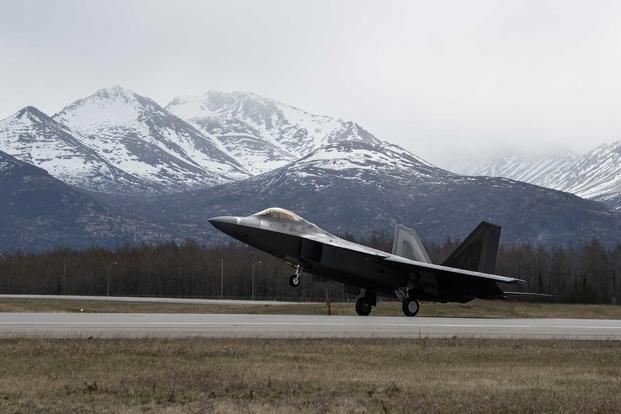An F-22 Raptor at Alaska's Joint Base Elmendorf-Richardson made an emergency landing on a base runway Wednesday afternoon, officials from the 3rd Wing said.
"The pilot was able to egress the aircraft safely," the 3rd Wing said in a statement. "The incident is under investigation."
"Initial reports indicate that yesterday's F-22 Raptor emergency landing at Joint Base Elmendorf-Richardson was the result of a landing gear malfunction. The pilot was able to exit the aircraft safely," the base said in a statement.
Photos surfaced on social media showing the F-22 leaning on its left side.
The latest incident comes months after an F-22, also assigned to JBER's 3rd Wing, experienced engine failure April 6 during a routine training flight at Tyndall Air Force Base. Days preceding the engine failure, another F-22 experienced a belly skid at Naval Air Station Fallon, Nevada.
Similarly, an F-35A from Eglin Air Force Base, Florida, experienced a nose-gear malfunction following an in-flight emergency near the base in August.
The Defense Department wants more attention and maintenance hours devoted to its fighter fleets, F-22s included.
Related content:
- Pentagon Suspends All F-35 Operations After South Carolina Crash
- Mattis Orders Supercharge in Fighter Jet Readiness
- Air Force Reports Second Mishap in 8 Days for Alaska-Based F-22s
The fifth-generation jet's mission-capable rate -- meaning the aircraft's ability to deploy at a moment's notice without issue -- is low compared to some of its fourth-generation counterparts.
According to Defense News' fiscal 2017 statistics, F-22s had a 49.01 percent mission-capable rate, meaning less than half were flyable at any given time. In 2014, more than three-quarters of F-22s were deemed mission capable.
This week, the Pentagon confirmed that Defense Secretary Jim Mattis aims to get the mission-capable rates of all F-22s, F-16 Fighting Falcons, F-35 Joint Strike Fighters and F/A-18 Hornets up to 80 percent by next September.
Mission-capable rates aside, the Air Force's F-22 inventory has faced numerous challenges.
In July, the Government Accountability Office said the F-22 is frequently underutilized, mainly due to maintenance challenges and fewer opportunities for pilot training, as well as the fleet's inefficient organizational structure.
"Unless the Air Force takes steps to assess and make necessary adjustments to the current organization and use of its F-22s, F-22 units are likely to continue to experience aircraft availability and pilot training rates that are below what they could be," the GAO said.
The latest F-22 mishap came just a day before Pentagon officials said its other premier fighter -- the F-35 -- would be temporarily grounded over potentially faulty fuel tubes within the engine.
All F-35 service variants were grounded Thursday, weeks after an F-35B crashed outside Marine Corps Air Station Beaufort. The move stems directly from the Sept. 28 crash, officials said.
-- Oriana Pawlyk can be reached at oriana.pawlyk@military.com. Follow her on Twitter at @Oriana0214.












